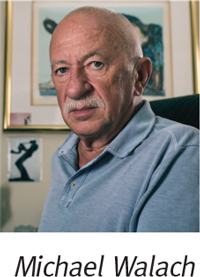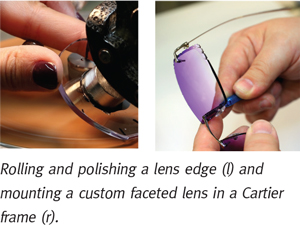RELATED CONTENT

The first two decades of the 21st century have seen many new developments and large investments in lab automation. Automating functions increases efficiency, reduces turnaround time and points of failure in lens fabrication and finishing, and almost everyone who knows the lab business would agree that the changes are for the best.
However, there are many vital functions that require skilled hands, experience, and creativity. VM spoke with several lab operators about these functions, and they identified several key areas where the human factor is crucial.
Finishing
Edging and mounting are two areas where a great deal of human skill is required. According to John Art, president of Interstate Lab Group based in Ontario, Ohio, “Assembly especially is a very complex task that requires an almost artistic skill to do properly.”
Borys Goldrajch, president of Pasch Optical in Sheridan, Colo, observed, “Most jobs can go to automated edgers if somebody separates them, but I’m guessing that 20 percent to 25 percent of jobs need loving care, and people have to be really involved in the process.” This starts with sorting the jobs—it takes a skilled eye to determine which can be edged automatically and which cannot.
Goldrajch said, “There are so many different frames, and a lot of the people who design the frames aren’t opticians, so the actual procedure of getting lenses into the frame can be quite complicated. We get a lot of non-standard frames so we have basically set up a department for special frames.”

|
|
|
|
Mounting can also be a challenge, and not just because of the frame shape, according to Mike Green, co-owner of Green Optics in Auburn Hills, Mich. “Human skill is necessary to handle the variety of frame materials and unusual mounting types today. Many of these require special skills. Different frame materials have their own unique characteristics such as buffalo horn, wood, optyl, propionate, polyamide and carbon fiber. Also, certain frame lines have very distinctive mounting systems such as, OVVO, Lindberg, Flair, Mykita, Seamless Bonded Rimless and Cartier.”
Green pointed out that other finishing areas also require unique skills. “Artistic talent and experience is essential to produce complex tinting, custom faceting, diamond cuts, roll and polished edges, crystal inlays, custom lens engraving designs, and air brushed edges.”
Inspection
Green said, “Although the optics of the finished product can be verified with automation, proper cosmetic inspection demands a sharp eye and years of experience to understand surface and edge quality, tint accuracy, the integrity of the frame character, and proper alignment.”
Goldrajch noted that judging the aesthetic qualities of the finished eyewear also requires a skilled eye. “When lenses come out and are inserted into the frame, it doesn’t necessarily mean that they look good. There’s got to be somebody with experience looking at it. We have a lot of finish people with experience in dispensing, because they see what issues patients complain about, and that’s what they watch for.”
Specialized Lenses and Problem Prescriptions
“In my experience, full-service labs in the U.S., up-to-date labs, are able to do over 99 percent of the jobs that they get,” said Michael Walach, founder of Quest Vision Care in Key Largo, Fla. “Every thousand jobs a full-service lab gets, there are approximately five jobs that they can’t do on automated production equipment.” Walach created Quest as a specialty lab to take care of these jobs, which range from difficult prescriptions to specialized lens designs.
“You get strong plus lenses where you have to use a strong front curve, whether it’s 10, 12 or 14 diopters, and you want to put it into a frame, but it would not be a lens you’d be able to wear. So you have to create something that doesn’t have a mathematical solution. You have to have the creative mind to imagine how it would be possible to do it. Then you have to have the skilled people that think out of the box. And you need specialized equipment.”
| 
|
|
|
This equipment includes vintage items such as a hand wheel. “That equipment was used 50, 60, 80 years ago, and it lets you create the lens by hand,” explained Walach. “You won’t see them anywhere today, but we have someone standing behind one for 8 to 10 hours a day.” Special gear like this allows the lab to create lenses that are beyond the range of current surfacing equipment. “We make 60 diopters of vertical imbalance, we make 15 diopter adds, we make 14 to 15 diopter cylinders,” said Walach. “There is always a solution if you really stretch your creativity, if you have the tools that are required and the mindset that you will never refuse a prescription.”
He pointed out that this type of work requires an unusual skill set that must be developed. “We have 22 people working in the lab. With the exception of two, none has ever worked in the optical business before. Once you get the right person, once you train them, you have to create conditions where you keep them forever, because it takes a long time to train people.”
Customer Service
Many businesses have extensively automated their customer service, but optical labs recognize the importance of experienced staff to handle customer questions and issues quickly and effectively. Said Art, “We’ve all been in a position of trying to find the secret phone buttons to push to get to a live person that can help us when we have a problem. There is nothing like talking to a real person when you have an unusual question or an issue that needs to be resolved. Even if you could anticipate every question and automate every solution, customers are still people and sometimes they want to talk.”

|
|
|
|
According to Green, achieving the premium customer service that practices insist on requires “an intimate knowledge of the customer and the experience to solve problems. It means understanding how to guide the customer through challenges they may be having with their patient and being able to recommend the proper solutions.”
While automated tools and processes will continue to develop, and will no doubt take over more functions that are currently done by hand, Green voiced the feelings of many lab operators when he said, “Machines will never be able to replace our skilled technicians when it comes to lens mounting, customizing lenses, cosmetic inspection of the finished product, and of course personal customer service.” And Goldrajch added a final note: “You have to put in that automation can never replace me, Borys.”